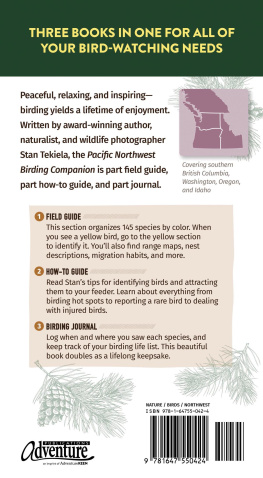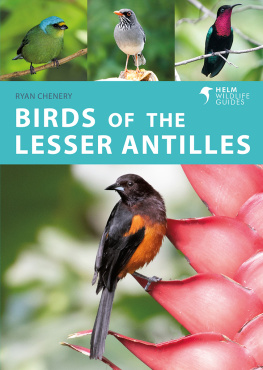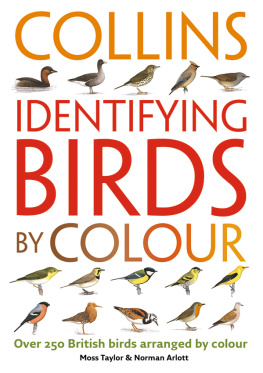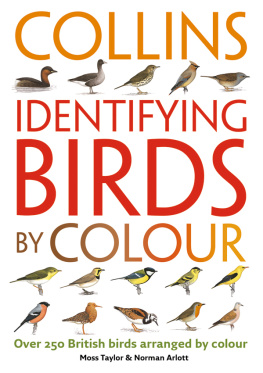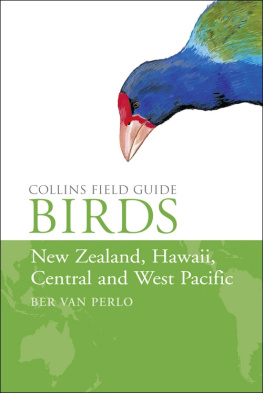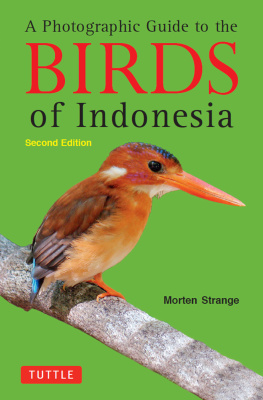
Bloomsbury Natural History
An imprint of Bloomsbury Publishing Plc
| 50 Bedford Square | 1385 Broadway |
| London | New York |
| WC1B 3DP | NY 10018 |
| UK | USA |
www.bloomsbury.com
This electronic edition published 2017
BLOOMSBURY and the Diana logo are trademarks of Bloomsbury Publishing Plc
First published by New Holland UK Ltd, 2000 as A Photographic Guide to Birds of the West Indies
This edition first published by Bloomsbury, 2017
Bloomsbury Publishing Plc, 2017
text G. Michael Flieg
photos Allan Sander, except where otherwise indicated
G. Michael Flieg has asserted his right under the Copyright, Designs and Patents Act, 1988, to be identified as Author of this work.
All rights reserved
You may not copy, distribute, transmit, reproduce or otherwise make available this publication (or any part of it) in any form, or by any means (including without limitation electronic, digital, optical, mechanical, photocopying, printing, recording or otherwise), without the prior written permission of the publisher. Any person who does any unauthorised act in relation to this publication may be liable to criminal prosecution and civil claims for damages.
No responsibility for loss caused to any individual or organization acting on or refraining from action as a result of the material in this publication can be accepted by Bloomsbury or the author.
British Library Cataloguing-in-Publication Data
A catalogue record for this book is available from the British Library.
Library of Congress Cataloguing-in-Publication data has been applied for.
ISBN: 978-1-4729-3814-5 (PB)
ISBN: 978-1-4729-3815-2 (eBook)
ISBN: 978-1-4729-3812-1 (ePDF)
To find out more about our authors and their books please visit www.bloomsbury.com where you will find extracts, author interviews and details of forthcoming events, and to be the first to hear about latest releases and special offers, sign up for our newsletters.
CONTENTS

INTRODUCTION
Birds of the West Indies illustrates over 250 of the regions more common species which either occur nowhere else in the world (endemic species) or are present in the region throughout the year or for a large part of it. Those species which simply migrate through the West Indies are not included, nor are rarer mainland species which wander here infrequently. Instead, the book concentrates on those species which are likely to be encountered by birdwatchers. The small size of this book enables one to carry it in a pocket for instant retrieval. Almost all of the photos have been taken in the field in the birds natural habitats.
There have been over 560 species recorded in the West Indies. Some species have become extinct (Grand Cayman Thrush), some have been rediscovered (Puerto Rican Nightjar), and others are known from but a few occurrences.
The West Indies are ideal for birdwatching. While exploring in a port of call, or simply vacationing in the sun, there is always some time available to explore and observe an islands birds. Each island presents a unique association of characteristic birds, many of which are endemic. If you have some free time, there may be adequate opportunity for a thorough introduction to the birdlife of a single island or group of islands.
The 250 species illustrated here are the more common and conspicuous birds of the West Indies; nearly all of the families found in this area are included. Also shown are some of the more rare, interesting and spectacular species. By studying these pictures carefully you should be able to identify a species when you encounter it. This book is not a complete guide, and pictures are not always sufficient for identification in the field. Behaviour, songs and views from different angles are all important, and a single photo is sometimes inadequate for proper identification. Notes and sketches can be important when using another sourcebook, at a later time, to identify a species. Often a single characteristic is enough to be certain of a birds identity, but it usually requires a combination of features to distinguish one species from another one which is closely allied to it.
Some birdwatching can be done without equipment. Many birds come to feeders, picnic tables and lawns, and are relatively tame. A pair of binoculars is an important tool for any birder, and their costs vary widely. Research the products on the market carefully for the one that fits your needs and budget.
Birds of the West Indies, by James Bond, was published in 1936. This book underwent many printings and several slight revisions, but in the end was unable to keep pace with advances in the ornithology of this region; by 1970 it had become outdated. It was not until 1975 that another field guide appeared, but it was specific to the Bahamas. In 1985 a Cayman Islands guide was produced, and a Puerto Rican and Virgin Islands guide followed in 1989. Birds of the Eastern Caribbean and Birds of Jamaica were published the following year. But still there was no guide to all the birdlife of the West Indies to replace Bonds. This void was filled in 1998 with the publication of A Guide to the Birds of the West Indies, compiled by the most prominent ornithologists of their respective areas. This book is comprehensive, and has raised the West Indian field guide to a new and higher level. Its publication has rendered Bonds volume obsolete, but we should never underestimate the importance of a work which stood the test of time for over 60 years. The new guide has incorporated species recently discovered or split from others; distribution ranges have been newly defined; it is well illustrated with paintings, and stands on its own.
HOW TO USE THIS BOOK
This book has been designed for clarity and with ease of use in mind. is a key to symbols used on each page of the main species descriptions. These symbols will guide the reader to a family or group of families to which each bird belongs. Each such symbol appears on the first full page bearing descriptions of that group. Photographs show the commonly seen plumage. Where there are two or more photographs they are generally of male and female, or adult and immature. The male or adult is usually on the top or left. Other captions are explained in the text.
The species descriptions follow the American Ornithologists Unions Check List of North American Birds, 7th edition (1983) for the taxonomic order, as well as for the scientific and common names of West Indian species. There have been a few changes to names based on recent researches. Each species description begins with the common name, scientific name and length of the living bird from bill tip to tip of tail. The next few sentences describe the main identification features. This is followed by a paragraph detailing range, habitat, voice, food, behaviour, and other features pertaining to the species. A glossary of terms used in the descriptions is given , and the diagram below shows the names applied to the different parts of a bird.



